Robbiee
Structural
- Jan 10, 2008
- 285
Hello,
We have a site where we will build 130mx80 one level underground basement/parking garage. There are two concrete 6-storey buildings above the basement that will occupy part of the footprint of the basement and the rest will be used as surface parking area and roads. Please see attached plan.
I have done a number of up to 90m long underground parking garages without expansion joints in walls and slabs with no major cracking issues. This one is 130m long.
The basements under the buildings are heated and the parking area of the basement will be provided with minimum heat to be kept above freezing temperature. We are located in an area that the temperature range from winter to summer is -19C to +31C. According to the Technical report No. 65 "Expansion joints in Building", we are fine without an expansion joint.
To help with shrinkage, we will provide control joints in walls every 7-8m and the slab will be poured with pour strips that will be kept open for 28 days. My questions are:
1- Do we need expansion joints in the walls and slab?
2- If not, any recommendations with the approach we are taking?
3- If expansion joints are needed, what are the suggested locations? separating the buildings from parking deck?
4- any other comments are appreciated.
Thanks
We have a site where we will build 130mx80 one level underground basement/parking garage. There are two concrete 6-storey buildings above the basement that will occupy part of the footprint of the basement and the rest will be used as surface parking area and roads. Please see attached plan.
I have done a number of up to 90m long underground parking garages without expansion joints in walls and slabs with no major cracking issues. This one is 130m long.
The basements under the buildings are heated and the parking area of the basement will be provided with minimum heat to be kept above freezing temperature. We are located in an area that the temperature range from winter to summer is -19C to +31C. According to the Technical report No. 65 "Expansion joints in Building", we are fine without an expansion joint.
To help with shrinkage, we will provide control joints in walls every 7-8m and the slab will be poured with pour strips that will be kept open for 28 days. My questions are:
1- Do we need expansion joints in the walls and slab?
2- If not, any recommendations with the approach we are taking?
3- If expansion joints are needed, what are the suggested locations? separating the buildings from parking deck?
4- any other comments are appreciated.
Thanks


